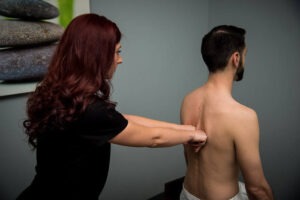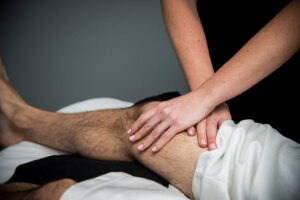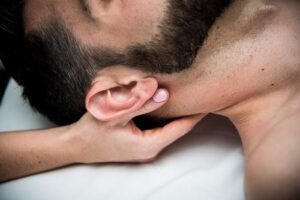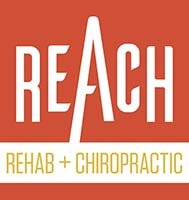
Kristin Szlinis working on posture with a client, utilizing Rolfing® methods.
Pain is the most common reason people visit our office, not Rolfing® (surprised?!). Did you know where you feel pain might not be the source of your discomfort? The pain we feel — no matter where it’s located — is the body’s request for change. By taking the time to understand your body and how you move, your needs, and your limitations we can craft a solution addressing the discomfort you feel AND the root cause of the problem.
What is Rolfing®?
Rolfing® Structural Integration is a series of 10 sessions. In the sessions, we take a holistic view of how pain, stress, and tension have affected your whole body and limited your ability to move.
Stress, poor movement, and compensation patterns permeate the entire body — they expand beyond where we can feel them. Treating only where you feel it is symptom management or “Band-Aid” care. Rolfing® treats the root cause.
Think of how easy it is to slouch after sitting too long. How natural it is to shift one side to avoid pressure on a sore hip. Changing stances to hold weight over one foot to ease discomfort in the other. To clench our jaw in anger. Or even holding our shoulders toward our ears in reaction to a stressful day.
The way we alter our body in response to pain is limitless and unique to you.
The response to stress and pain causes many joints to change position. We do this even if the altered positions don’t help reduce the negative feeling — it’s a subconscious body response. And becomes a habitual coping mechanism.
When we habitually use altered positions we begin to move unevenly and lopsided. We become less efficient with our movements, which creates even more strain. This strain and tension make us hurt more. It causes muscles to tighten further.
The problem isn’t just where you feel it (the symptom), it’s the deep compensation patterns and tension developed to deal with the pain and stress. The body’s adaptation to the root cause creates progressive discomfort AND unfavorable movement patterns, which results in pain.
Over ten sessions, we work tip to toe, analyzing how each part of your body works. We use hands-on manual work to improve range of motion and “undo” built-up tension, allowing your body to heal. And I coach you on how to use the newly found range of motion to cement the changes.
During the process, you learn how to tune in and listen to your body. You understand how to deal with former habits when they pop up, to prevent a build-up of tension in the future.
Common Causes of Problems Where Rolfing® Helps
Humans are designed for movement — not staring at electronics or being under constant stress. The way we’ve contorted our bodies to accommodate modern living has hindered our ability to achieve optimal health.
Whether you’ve had an injury a long time ago, a traumatic accident, chronic stress, or pain for no apparent reason, humans need frequent movement for their bodies to function properly. Our bodies need to function properly to heal.
Posture and body mechanics are developed and strengthened through movement. Frequent physical and emotional stresses change the tension our body uses to move (our posture).
All the parts of our body are interrelated. They must work in concert to perform for proper movement. When poor alignment and movement patterns occur, it stresses the entire system.
When your movement is limited by tension, tightness, and discomfort it’s a warning sign your body is struggling to keep one of its systems healthy. In essence, if you can’t move well, you’re not as healthy as you could be!
What Rolfing® Isn’t
Pain and stress are most often a protective mechanism, not the result of damage. Our brain’s job is to keep us alive and often the pain/stress we feel is simply a request from our brain to change before something bad happens. Pain is a high alert that we need to change our behaviors.
Chronic pain is your brain’s way of requesting a change as well. Even if you have a diagnosis, e.g., bulging disc, arthritis, degeneration, etc., your brain is still requesting you shift your behavior to better accommodate your body.
Rolfing® Structural Integration will help you find sustainable changes in your behavior that reduce pain, tension, tightness, and stress.
DISCLAIMER: This is not medical advice. In rare cases, pain can indicate serious medical problems requiring immediate attention. If you experience dizziness, double vision, difficulty speaking/swallowing, direct trauma or unexplained weight loss seek immediate attention.
Rolfing® Can Help
Rolfing® Structural Integration’s unique approach to improving body awareness, decrease pain, and improving range of motion makes it a great treatment option for many conditions. Some of the conditions we’ve helped to relieve include:
- Tension, muscle aches, and soreness

- Stress
- Arthritis
- Bulging/Herniated Disc
- Degenerative Disc Disease
- Degenerative Joint Disease
- Disc surgeries/failed back surgery
- Headaches
- Hip pain
- Impingement syndrome
- Iliotibial band (IT) syndrome
- Jaw pain and TMJ disorders
- Joint pain
- Knee pain
- Lower back pain
- Muscle strain/pulls
- Neck pain

- Overuse injuries
- Piriformis syndrome
- Pinched nerves
- Plantar fasciitis
- Rotator cuff syndrome
- Sacral pain and SI joint dysfunction
- Sciatica
- Shoulder pain
- Frozen shoulder/Adhesive Capsulitis
- Soft tissue adhesions
What You Can Do
Pain is frustrating. Stress can be overwhelming. Below are some self-help tips that can help you reduce discomfort and give you a head start to your Rolfing® series.
- Use “Body Scans” regularly to reduce tension
- Take mental (or physical!) notes what you are doing/thinking when your pain feels better or worse to identify any behavioral/emotional patterns
- Take deep breaths
- Avoid sitting for more than 30 minutes
- Walk for 20 minutes per day without phones, dogs, or distractions.
Still Struggling?
The goal isn’t to “fix” you, rather the goal is to work with you to create better habits and improve your mobility.
Many therapies claim to release tissue and realign your body but what good is that if you go back to moving the same way you did before?
By using both hands-on and awareness-building activities Rolfing® creates sustainable changes in your posture, movement, and health potential. The techniques you learn with Rolfing® will help you for a lifetime.

